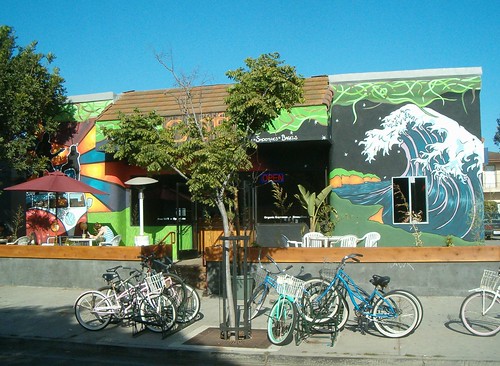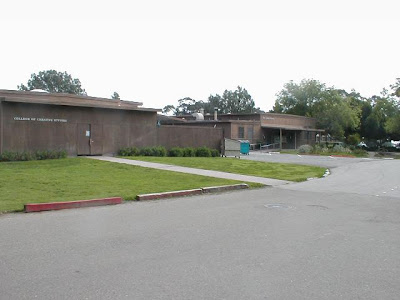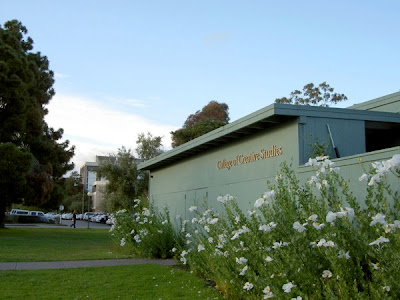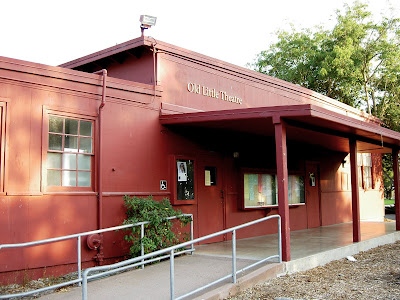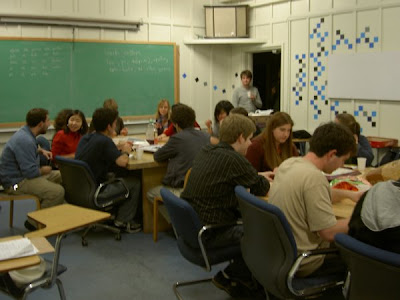Hello, all! Danielle here, pinch-blogging for Britta to give you the happenings from the Literature meeting held last Friday:
Notes
The Annual Literature Meeting began on a somber note, with Bruce having to explain to us that a beloved teacher was going to have to take the remainder of the quarter off. As a result:
- Solo Authors is canceled. Students will be rewarded 2 units for work already completed.
- Donelan takes control of Milton after a week and a half hiatus.
- Graphic Novels will be covered by another professor.
- Lim will oversee the creative writing advisees as well as independent studies and my colloquium.
A "Thinking Of You" card will be circulating throughout classes to be signed by all students who feel so inclined this week and next.
After the bad news, we received some better news. Changes are happening within the Lit program in order to make ours as defined and organized as all the others in CCS. Most of the changes that will be implemented to support this project sound great so far.
In conjunction with the struggle to cover Robyn's classes and advisees, more student advisers are being sought out so each professor will have fewer students to advise and we, in turn, will receive more one-on-one mentorship.
Classes will be outlined hopefully a full year in advance to aid in planning of schedules.
Bruce is working to expand the breadth of topics covered by Literature classes, as in recent years they have been mostly regarding the same types of subjects (ie. specific authors, time periods, regions). In the past, however, Literature classes ranged from philosophy, religion, history, etc. studied through "a literary lens."To help bring in new literary topics outside of our usual studies, professors from departments including German/Slavic Studies and Psychology will be on loan.
A few students, including myself, will be working with Leslie to define more clearly the requirements for Literature majors in order to graduate. Lists will be drafted to clarify which classes fulfill the breadth and related reqs.
The mid-residency review process is still being polished, but its basic function remains this: to determine after a few quarters in CCS if a student is really meant to remain within the college, or might possibly be best served in another deparment. This decision will rest in the hands of a panel of faculty that will review a student's portfolio as it stands at the end of the sophomore year.
The senior portfolio is also a work-in-progress. They are not required this year but may be next year. The senior portfolio will also be critiqued by a panel of faculty to polish the set of work for graduate school applications and resumes.
Bruce introduced the idea of a Literature Symposium that all freshmen would take to reveal to all students the resources that are available to them at our university. The skills focused on in this one-quarter class would aid students in writing university-level papers and the general critical study of literature.
Spectrum and Teeth for this year have received full funding but other arrangements need to be made to match their budgets against next year. One goal Bruce has for Spectrum and Teeth is to reopen them to the literary world on a national level by increasing circulation.
These are the changes that so far are in effect/being finalized. Some other problems with the Literature program were brought to the Dean's attention by students.
Colloquiums are remaining at two units but the prospect of a writing workship colloquium counting for writing requirement credit was proposed. Bruce agreed that with a supplemental two-unit independent study with a faculty member would allow this.
The number of L&S students appearing in writing classes was brought up in relation to lack of opportunities to fulfill writing requirements. Marthine is going to be researching the ratio of L&S students to CCS Lit students in all classes, not just Creative Writing, to determine if this is a valid concern. Among the possible solutions suggested were a weeding-out process for any non-CCS Lit students in the form of a submitted piece of work to the professor.
Thoughts
The final concern voiced was the monotony of Literature Symposium. Whether students realize it or not, Literature Symposium is an opportunity to hear from many different kinds of people, writers and performers and publishers alike. It exposes us to a variety of careers and genres of writing and even the speakers we hate further educate us in what we do not want to do. As long as speakers are not being repeated within the year, we really have no right to complain. On top of all of this, it is only one hour a week. What doesn't kill us, makes us a stronger, for lack of a better way of phrasing that thought.
This brings me to a point of Bruce's I would like to touch on. Many Literature students waste their time complaining about the Literature class offerings not fulfilling every one of their educational desires. What many Literature students do not realize is that all other CCS majors receive the majority of their education outside of CCS. There are hundreds of classes out there in the university that will provide the subjects and studies we all want to persue. CCS cannot cover everything. The Literature program should primarily concern itself with teaching classes we cannot get outside of the college, otherwise money and time is being wasted. Also, a variety of professors should be circulated through CCS in order to give us all well-rounded educations.
These are all important things we need to think about concerning our futures in CCS and within the Literature major. We also need to keep in mind that Bruce cannot come up with a solution to every single problem we come up with. Changes take a lot of time and Bruce does his best to listen to everyone and take all opinions into account.
If you by choice did not attend the Literature meeting, seriously think about attending next year. Not only is it the perfect forum to have a say in your education (which you're paying thousands of dollars for), but it's also a great way to meet other Literature students and get to know our loveable Dean.
Thanks to Britta for having me as a guest blogger on the official Literature Collaborative blog =)






